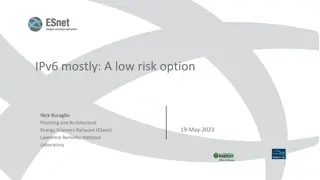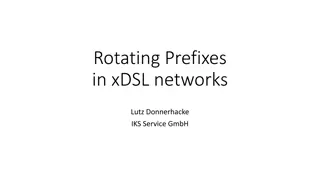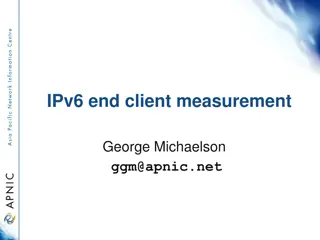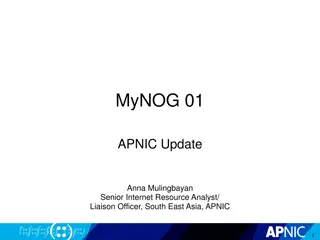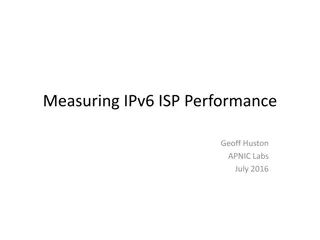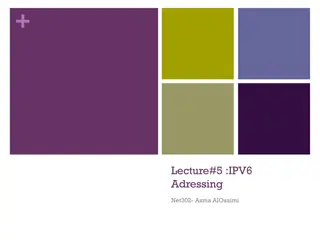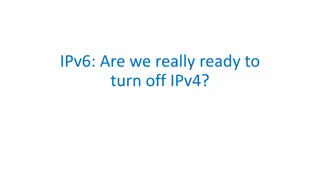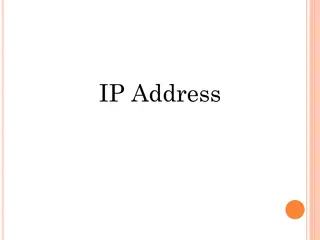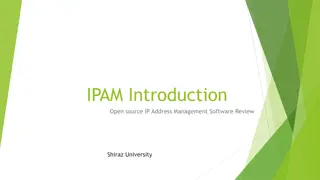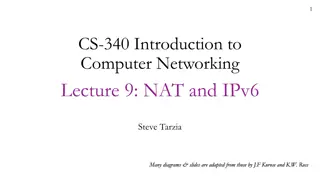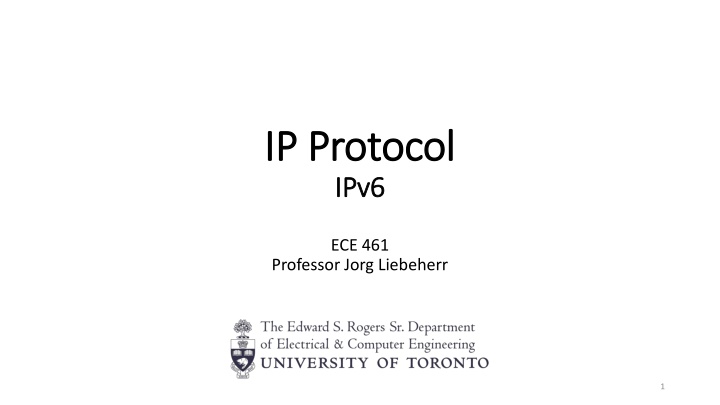
Understanding IPv6 Header Simplification
"Explore the simplified structure of IPv6 headers compared to IPv4, including daisy-chaining and key features like fixed size, no fragmentation, and the role of fields. Learn about the service offerings, packet headers, and extension headers in IPv6."
Download Presentation

Please find below an Image/Link to download the presentation.
The content on the website is provided AS IS for your information and personal use only. It may not be sold, licensed, or shared on other websites without obtaining consent from the author. If you encounter any issues during the download, it is possible that the publisher has removed the file from their server.
You are allowed to download the files provided on this website for personal or commercial use, subject to the condition that they are used lawfully. All files are the property of their respective owners.
The content on the website is provided AS IS for your information and personal use only. It may not be sold, licensed, or shared on other websites without obtaining consent from the author.
E N D
Presentation Transcript
IP Protocol IP Protocol IPv6 IPv6 ECE 461 Professor Jorg Liebeherr 1
Takeaways Takeaways Simplification of the IPv6 header compared to IPv4 Understand the daisy-chaining of headers using the Next header field 2
Service of IPv6 Service of IPv6 IPv6 offers the same unreliable, connectionless, best effort service as IPv4 3
IPv6 packet header IPv6 packet header IPv6 has a simplified header structure: Headers have fixed size No fragmentation (available as option) No header checksum Most fields play a similar role as in IPv4: IPv6 IPv4 Version Traffic class Payload length Next Header Hop Limit Version DS Total length Protocol TTL similar to Flow label: Can be used by a source to label packets from the same flow 4
Extension Headers Extension Headers Instead of header options, IPv6 allows to concatenate optional headers to the main header Extension Headers: Security: Authentication Fragmentation Routing Payload Header (TCP, UDP, ) IPv6 Header Next Header =TCPTCP Header DATA Fragmentation Header Next Header =TCP IPv6 Header Next Header = Security Security Header Next Header = Fragementation TCP Header DATA 5
IPv6 header format IPv6 header format 32 bits Version: set to 6 in IPv6 version (4 bits) Traffic Class (8 bits) Flow Label (20 bits) Next Header (8 bits) Payload Length (16 bits) Hop Limit (8 bits) Traffic class: same interpretation as the DS field in IPv4 Source IP address (128 bits) Note: There is no header size field. Headers (not including header extensions) are always 40 bytes Destination IP address (128 bits) 6
IPv6 header format IPv6 header format 32 bits Flow label A flow is a group of datagrams from a source to a destination (e.g., packets of a video stream) Flow label is an identifier for a flow Set by the source Flow label of zero indicates that the datagram does not belong to any flow version (4 bits) Traffic Class (8 bits) Flow Label (20 bits) Next Header (8 bits) Payload Length (16 bits) Hop Limit (8 bits) Source IP address (128 bits) Destination IP address (128 bits) 7
IPv6 header format IPv6 header format 32 bits Payload length Number of bytes following the fixed header Max. 216 -1 bytes = 65535 bytes Longer payloads (jumbograms) can be specified in an extension header with max. 232 -1 bytes 4 GB version (4 bits) Traffic Class (8 bits) Flow Label (20 bits) Next Header (8 bits) Payload Length (16 bits) Hop Limit (8 bits) Source IP address (128 bits) Note: Extension header is counted as payload Destination IP address (128 bits) 8
IPv6 header format IPv6 header format 32 bits Next Header version (4 bits) Traffic Class (8 bits) Flow Label (20 bits) Next Header (8 bits) Two uses: Payload Length (16 bits) Hop Limit (8 bits) 1. Specifies the next header: Routing header (43) Fragment header (44) Authentication header (51) Hop-by-hop option (0) No next header (59) Source IP address (128 bits) 2. Specifies higher layer data: TCP (6) UDP (17) ICMPv6 (58) Destination IP address (128 bits) 9
IPv6 header format IPv6 header format 32 bits Hop limit version (4 bits) Traffic Class (8 bits) Flow Label (20 bits) Next Header (8 bits) Same role as TTL field in IPv4 Payload Length (16 bits) Hop Limit (8 bits) Default values (set by sources) are usually 64 or 128 Source IP address (128 bits) Destination IP address (128 bits) 10
Fragmentation in IPv6 Fragmentation in IPv6 IPv6 allows fragmentation only at the source Information about offsets is stored in Fragment header Intermediate routers never perform fragmentation If MTU is too small, datagram is dropped and error message (ICMP) is sent IPv6 performs Path MTU discovery Path MTU = max. datagram size used between a source and a given destination Path MTU min. MTU on any link between source and destination Minimum required MTU in IPv6 is 1280 bytes 11





